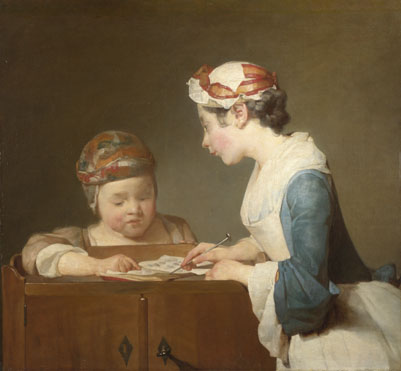Accession #: 2005.0042EC
 In the eighteenth-century children of both sexes were dressed similarly in petticoats and kept their hair long. Bibbed aprons were also popular. It can sometimes be difficult to determine if a child in a colonial portrait is a boy or a girl. Around the age of five a male child would be "breeched" and dressed in their first pair of breeches.
In the eighteenth-century children of both sexes were dressed similarly in petticoats and kept their hair long. Bibbed aprons were also popular. It can sometimes be difficult to determine if a child in a colonial portrait is a boy or a girl. Around the age of five a male child would be "breeched" and dressed in their first pair of breeches. A unique article of clothing specifically intended for toddlers learning to walk were pudding caps - padded helmets protecting them from injury due to accidental falls and bumps into furniture.
There are multiple theories to how the nickname of “pudding” came about. One source from the UK states that the padded rolls showed a similarity to the shape and size of a sausage named black pudding, a popular food still enjoyed today. A curator at Colonial Williamsburg claims the source of the name came from the caps “resemblance to the shape of pudding or pudding bowls.”

Regardless of where the name came from, many of the pudding caps shared a similar construction. A simple cap was made of a horseshoe shaped roll that tied around the head in the back, typically with four triangular flaps that attached/ tied at the top of the head with ribbon. Horse hair and other materials were used for stuffing and padding the cap. The ties in the back and at the top allowed for adjustments to accommodate a growing child’s head. Many of the pudding caps were designed for everyday wear and tear; made out of dark fabric to disguise stains and dirt. For a more grand styled pudding cap, leathers, silks and fur trims were frequently in fashion.
The reproduction pudding cap at Wilton is made of a combination of green velvet and leather, showcasing the prosperity of the family. This item is currently on display in the nursery, where it would have been worn by one of the many Randolph children of Wilton.
Bibliography
Baumgarten, Linda. What Clothes Reveal: The Language of Clothing in Colonial and Federal America : the Colonial Williamsburg Collection.
Yale University Press, 2002. 160-167. eBook.
"'Pudding' safety hat." Museum of Childhood. N.p.. Web. 24 Oct 2013. <http://www.museumofchildhood.org.uk/collections/clothing/pudding-safety-hat/>.
Image Credit
Chardin, Jean-Siméon. The Young Schoolmistress.
1735. Painting. The National Gallery, Trafalgar Square, London. Web. 24
Oct 2013.
<http://www.nationalgallery.org.uk/paintings/jean-simeon-chardin-the-young-schoolmistress>.
Wilton House Museum



